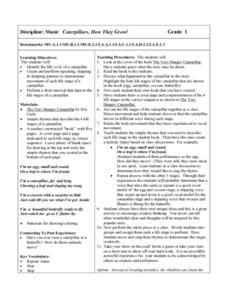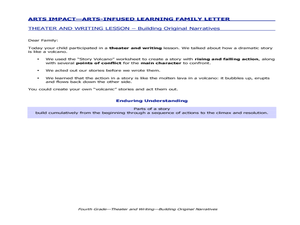GNS Science
Think like a Geologist: 1
How well do pupils play the role of geologist? Test their abilities in the first installment of a two-part series. Presented with a series of rock formation diagrams, learners write stories to match what they see in the diagrams. The...
Curated OER
Order! Order!
Polish organization skills in your youngsters. With this lesson plan, they are introduced to the trait of organization and participate in activities that reinforce organization. They cut apart a familiar story, receive different parts of...
Curated OER
The "Write" Stuff: Strategies and Conventions for Imaginative Writing
Fifth graders develop and practice the steps involved in imaginative writing. They follow the steps/worksheets included and write imaginative stories of their own.
Curated OER
Music: Caterpillars, How They Grow!
Put on some music and get moving as a way to represent the life cycle of a caterpillar. Kids listen to the story The Very Hungary Caterpillar, discuss the life cycle, then create vocal expression that represent each stage of the cycle....
Curated OER
CAN WE SWITCH GENDERS OF STORY CHARACTERS?
Analyze characters and stories to identify stereotyping. Learners will examine the concept of character gender to evaluate bias in classroom story books. They are asked to read a story or play and change the gender of the character to...
Hawaiʻi State Department of Education
Cinderella
Reading fairy tales is so much fun! Learners use dramatic play to assist them in defining and expressing the main theme found in the story of Cinderella. Each group is given a story card and will create a tableau based on the main point...
Curated OER
Using Connectives Correctly
After delving into the proper use of conjunctions, learners write their own stories focusing on using connecting words. First, they discuss the different types of conjunctions. Those include conjunctions used to add further information,...
Curated OER
The Very Hungry Caterpillar
Learners complete various activities related to the book "The Very Hungry Caterpillar." They participate in a shared reading activity, read and write a sentence for each day of the week, draw a picture of the caterpillar eating one of...
Curated OER
Great Expectations: Group Writing
Examine the differences between totalitarianism and democracy in this writing lesson plan. Using the same format and theme from Great Expectations, young writers work in pairs to compose their own short stories. They follow guidelines...
Curated OER
Building Original Narratives
Fourth graders act out and write original narratives. In this theater meets writing lesson, 4th graders work in groups to create original narratives; after students act out their story, they write it down as a narrative.
Curated OER
Chicka Chicka Boom Boom
Young readers write alphabet letters. They review the alphabet and examine the relationship between letters and sounds. A final activity has each child sequence the story together.
Curated OER
Crater Creation
After looking at the back of a quarter featuring Oregon terrain, learners distinguish between fiction and non-fiction and identify the beginning, middle and end of a story. First, they listen to legends that describe the creation of...
Film English
Two Fingers
Ask your class to think about how song lyrics can go with a video and more with a well-sequenced lesson plan that focuses on the song "Two Fingers" by Jake Bugg. Class members work together to make predictions about the content of the...
Curated OER
Aboriginal Legends
Students listen to and read legends and see that these legends helped the Aboriginals explain their everyday life. Through their stories and legends we find that Aboriginal values, attitudes and cultural identities are shared.
Curated OER
Personal Experience Narratives
Help your middle schoolers identify personal experience narratives in their own lives through telling stories themselves and from family members or other adults. They study personal experience narratives in Swapping Stories and compare...
Curated OER
Maus: Making a Visual Representation
How do you represent a tragic event? Are stories of tragic events better left untold? After reading chapter two of Maus and studying other representations of the Holocaust (suggestions are included), class members create a representation...
Curated OER
Moby Dick Puppetry
Such an ambitious lesson! Third graders with special needs listen to an audio recording of the novel, Moby Dick. They stop often to discuss each of the main characters and analyze their actions in the story. They then make puppets of one...
Curated OER
Narrative Writing vs. Explanatory Writing
The class discusses the different purposes an author has for writing. The focus of the discussion is on writing to tell a true story and writing to give information about a specific topic. There are writing purpose sorting cards embedded...
Curated OER
“THE LORAX” by Dr. Seuss
Few children's books convey the message of conservation as well as Dr. Seuss' The Lorax. Read the story aloud, emphasizing the interconnectedness of plants and animals in an ecosystem and discussing different ways people can help the...
Curated OER
Playground Mapping
Students convert their physical models of a playground from a previous lesson into a map of the playground that includes a scale and key. They examine and discuss examples of maps, view an image to map photo essay, and create a map using...
Curated OER
Flip and Flop: An Adaptation Through Dancing Echoes with Shapes and Locomotor Movement
Dancers practice echoing through dance. They listen to a story "Flip and Flop" and then are put into pairs. One partner is Flip, while the other is Flop. Flip creates a shape by dancing, and Flop, the other student, echoes that shape by...
Curated OER
Finding the Main Idea
The carnival is in town! After reading a short excerpt about a day at the carnival, learners use details to determine the story's main idea. They must differentiate the details from the big picture, as there are multiple options they can...
Curated OER
Text Structure Booklet
Middle schoolers work on comparing and contrasting different text structures with this project. First, they study an example of a sample page in a booklet, which they go on to use as a model. They complete a booklet with text structure,...
West Virginia Department of Education
Harpers Ferry Letters
Scholars write letters as if they were someone who heard the story of John Brown's raid. The resource, a standalone, covers information from primary sources that is important to West Virginian history: the Harpers Ferry Letters.
Other popular searches
- Story Sequencing Worksheets
- Sequencing a Story
- Picture Story Sequencing
- Story Sequencing Halloween
- Story Sequencing Activities
- Story Sequencing Rubric
- Sequencing Story Events
- Short Story Sequencing
- Story Sequencing Exercises
- Story Sequencing Pictures
- Story Sequencing Map
- Sequencing Story

























